Cells and control
1/91
There's no tags or description
Looks like no tags are added yet.
Name | Mastery | Learn | Test | Matching | Spaced |
|---|
No study sessions yet.
92 Terms
What are the 6 stages of mitosis?
Interphase
Prophase
Metaphase
Anaphase
Telophase
Cytokinesis
What happens in interphase?
The cell spends most of its life in this phase. The DNA in chromosomes and cell organelles copy themselves ready for mitosis.
What happens in anaphase?
The chromosomes are pulled apart by the spindles to each end of the cell
What happens during telophase?
The single chromosomes arrive at opposite ends of the cell and the membranes around the chromosomes starts to form again
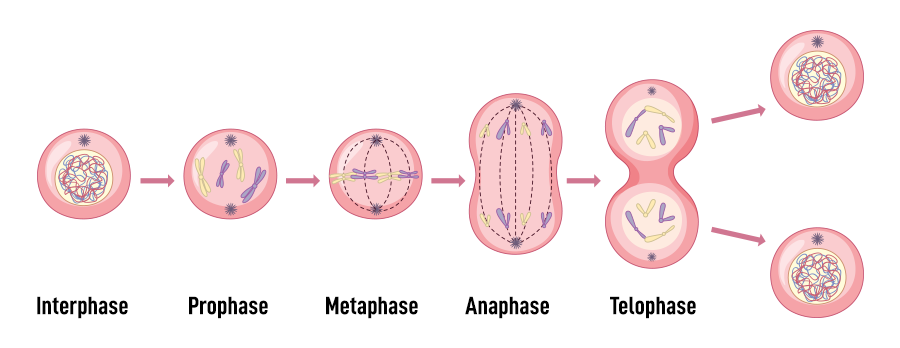
What do red blood cells do and how are they specialised?
They carry oxygen to cells and take carbon dioxide away
They have a bi-concave shape which maximises their surface area to absorb oxygen
Contain haemoglobin which can bind 4 oxygen molecules to it
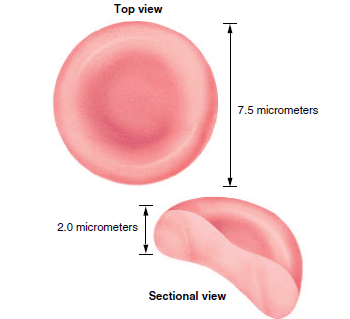
\-They are very long (up to 2m)
What do sperm cells do and how are they specialised?
-They carry half the genetic information
-They have a tail to swim to the egg cell
-They have acrosomes (enzymes) that let them penetrate the jelly coat of the egg cell
\-They have hairs to help them do this
\-They do not contain chloroplasts as sunlight cannot get to them, this means they have more space to contain water
\-contains a large number of chloroplasts on their surface that help to absorb a large amount of sunlight
\-Found in places where growth takes place (shoots and roots)
\-Bends when full with water to open stomata
\-Controls water loss and gas exchange
\-Stomata opens during the day for photosynthesis
\-Xylem vessel consist of dead cells
\-Thick cell walls with hollow middle
\-Involved in the movement of water within a plant
Skin-Pressure/temperature
Tongue-Chemicals
Nose-Chemicals
Ears-sound
What do motor neurones do?
They carry the nerve impulse to an effector
Put the nervous system response in order
Stimuli, receptor, sensory neurone, central nervous system, relay neurone, motor neurone and effectors
Why is the reflex arc useful?
Because it does not involve conscious parts of the brain making it much quicker
What is the order of a reflex arc response?
Stimulus: touching a hot object for example
Impulse starts at receptor cells, passed along to the sensory neurone
Then passed along to spinal cord- in the reflex arc, the conscious part of the brain is not involved
The relay neurone then passes impulse onto the motor neurone
Effector receives impulse to react
Response: lift finger away from hot object
What are neurotransmitters?
A chemical that passes across the synapse (gap between two neurones) to pass the impulse onto the next neurone
How do neurotransmitters carry chemical signals from a neurone to the target cell?
The nerve impulse arrives at the synapse
Chemical messenger (a neurotransmitter) is released into the synapse
The neurotransmitters diffuse across the synapse
When the next nerve is reached, the neurotransmitters start another impulse
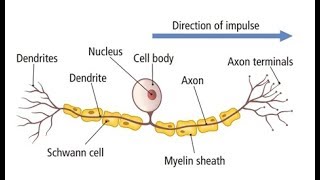
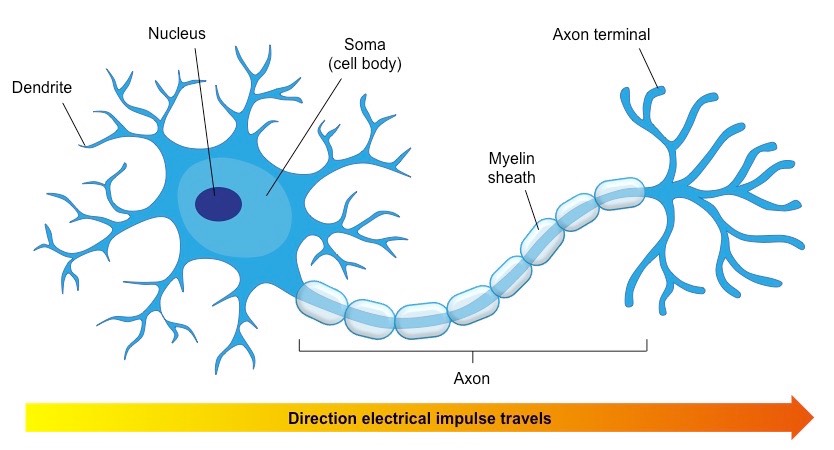
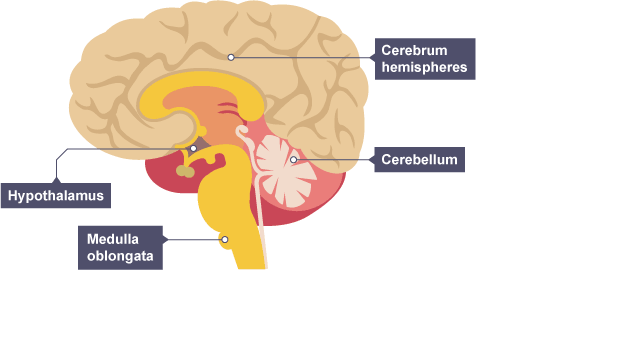
What does the cerebrum do?
It is split into two hemispheres (called the cerebral hemispheres) and is highly folded. It controls intelligence, personality, conscious thought and high-level functions, such as language and verbal memory.
(The outer layer of the cerebrum is called the cerebral cortex)
What does the medulla oblongata do?
Controls unconscious activities such as heart rate and breathing rate
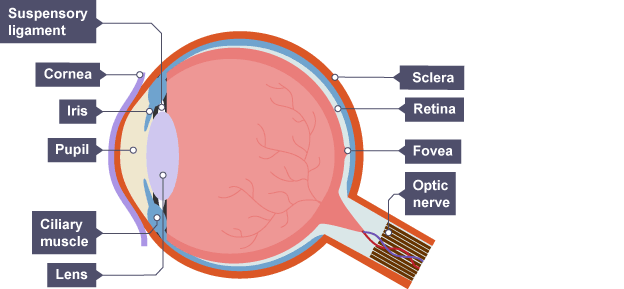
Iris: Controls how much light enters the pupil
Lens: Further refracts light to focus it onto the retina
Retina: Contains the light receptors
Optic nerve: Carries impulses between the eye and the brain
Sclera: Tough white outer layer of the eye. It helps protect the eye from injury
The amount of light entering the eye is controlled by a reflex action. The size of the **pupil** changes in response to bright or dim light. This is controlled by the muscles of the iris.
Flip over for image explaining how the eye changes to focus on near and far objects
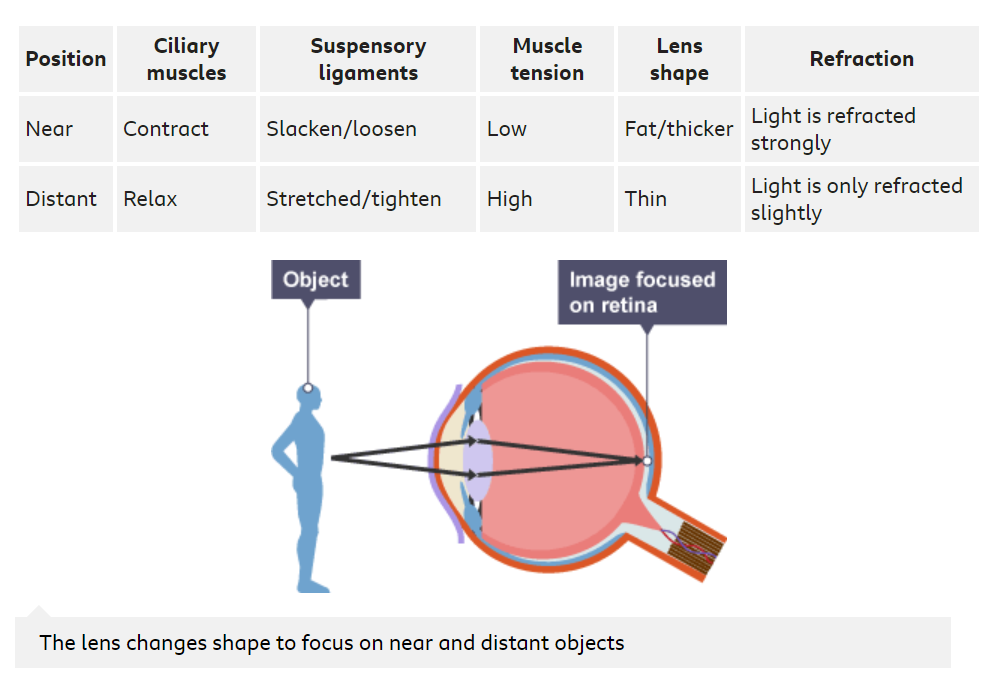
What can short sightedness be caused by?
The eyeball being elongated - so that the distance between the lens and the retina is too great.
The lens being too thick and curved - so that light is focused in front of the retina.
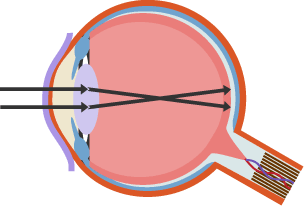
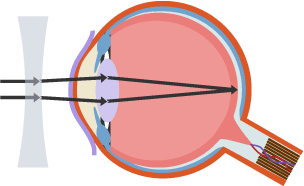
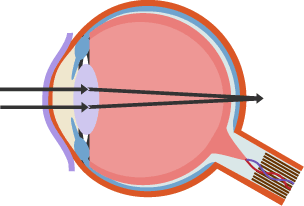
* a loss of elasticity in the lens - meaning it cannot become thick enough to focus (which is often age-related)
How is long sightedness corrected?
Long-sightedness is corrected by putting a convex lens in front of the eye
How do replacement lens correct vision?
Implanting artificial lenses is a recent development, and can placed in front of the original lens, through a small cut in the cornea, to correct an eye defect.
What is differentiation?
When a normal, undifferentiated cell turns into a specialised cell to carry out a particular function
What is the zone of elongation in a plant?
The area where cells are dividing rapidly to make more new cells
What two ways can growth be estimated?
Change in length and change in mass
How do you read a percentile chart?
Assume a graph is showing the weight of babies
On a graph you will be told which line in which percentile
If the line is the 95th percentile then 95% of babies will be under this mass
If a baby’s weight is above the 95th percentile or below the 5th percentile it may not be growing properly
If a baby’s mass drops by two or more percentiles over a year, it may not be growing properly
What are stem cells?
Unspecialised cells that can differentiate into any other cells
What are embryonic stem cells?
Stem cells taken from embryos in early stages of development which can differentiate into any other type of cell
What are adult stem cells?
Stem cells taken from differentiated tissue such as bones or skin
They divide to replace damaged cells
What are the uses of embryonic stem cells?
Replacing or repairing brain cells to treat people with Parkinson’s disease
Replaces damaged cells in the retina of eye to treat some kinds of blindness
Growing new tissues in the lab to use for transplants or drug testing
What are the uses of adult stem cells (from bone marrow)?
Treatment of leukaemia (cancers of the white blood cells, starting in the bone marrow)
Potentially growing new tissues that are genetically matched to the patient
What are the advantages and disadvantages of using embryonic stem cells?
Easy to extract from embryo
Produce any type of cell
Embryo destroyed when cells removed- some people think embryos have a right to life
What are the advantages and disadvantages of using adult stem cells?
No embryo destroyed so no ethical issue
If taken from the person to be treated, will not cause rejection by the body
Produces only a few types of cell
What advantage do all kinds of stem cells have?
They replace faulty cells with healthy cells, so the person is well again
What is the risk for all kinds of stem cells?
Stem cells may not stop dividing, causing cancer
What is stem cell rejection?
When a donors stem cells are not accepted by the patients body, the immune system attacks the stem cells
What happens in a CT scan?
The patient is give a radioactive tracer which allows different parts of the brain to show up
A CT scan is carried out, taking many different X-rays of the skull and brain from different angles
A computer puts all these things together to give a three- dimensional image
What happens in a PET scan?
The patient is given a small amount of a radioactive form of glucose
This travels to parts of the body where respiration is happening rapidly
This shows up as changes in parts of the body such as the brain that might indicate damage or disease
The scanner detects the radioactivity and builds up images showing where the radioactive tracer is most concentrated
How does breaking your spinal cord cause you to be paralysed?
Nerve impulses to and from the lower part of the body pass through the spinal cord
If this is damaged then there is no way the nerve impulse can be carried from the brain to lower parts of the body
What is the difference between the spine and spinal cord?
The spinal cord is made of nerves and this lies inside the spine for protection
Why is damage to the nervous system so difficult to treat?
All of the separate parts are well protected
Why is the brain so hard to treat?
Protected by the skull
Capillaries that supply the brain are not as leaky as normal capillaries- this is called the blood-brain barrier and it makes it difficult to get medicines into the brain
Neurones are specialised so they cannot divide to replace damaged cells
Why is the spinal cord so hard to treat?
It is protected by the spine
Neurones are specialised so they cannot divide to replace damaged cells
Why can treating a brain tumour with radiotherapy be dangerous?
Radiotherapy can not only remove the tumour but also damage healthy nerve cells
What is cataracts and how can it be treated?
When the lens becomes cloudy
It is caused when proteins in the lens of the eye break down and clump up together
This causes a blurred image
It can be treated by replacing the cloudy lens with an artificial lens
What is colour blindness caused by?
A normal retina contains three types of cones that can detect blue, green and red light. The colour of an image is detected by how much each type of cone is stimulated
In colour blindness, at least one type of cone is missing or does not work properly
This occurs mostly in males
In red-green colour blindness, either red or green cones are missing, and the person cannot distinguish between the two colours